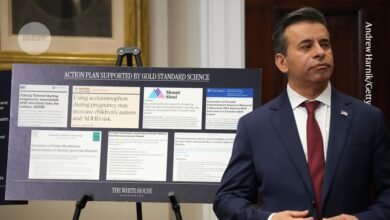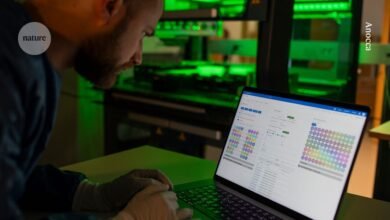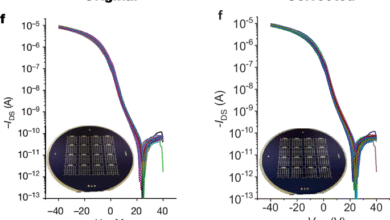
Sponsor message 00:00
This Working Scientist podcast series is sponsored by the University of Queensland, where research is addressing some of the world’s most challenging and complex problems. Take your research further at UQ. Visit uq.edu.au
Juliana Gil: 00:25
Hello, this is How to Save Humanity in 17 Goals, a podcast brought to you by Nature Careers in partnership with Nature Food.
I am Juliana Gil, chief editor of Nature Food. Welcome again to the series where we meet the scientists working towards the Sustainable Development Goals, agreed by the United Nations and world leaders in 2015.
For almost a decade, in a huge global effort, thousands of researchers have been using those targets to tackle the biggest problems that the planet faces today.
In episode five, we look at Sustainable Development Goal number 5: how to achieve gender equality and empower all women and girls.
And we meet two female academics from the University of Melbourne, Australia, who are part of an affirmative action strategy that led to very striking outcomes.
Elaine Wong: 01:22
Hi, my name is Elaine Wong, and I am Pro Vice Chancellor of people and equity at the University of Melbourne, Australia.
I previously held the position of Associate Dean (diversity and inclusion) at the Faculty of Engineering and Information Technology at the university.
Georgina Such 01:38
Hi, my name is Georgina Such. I’m an associate professor in the faculty of science. But I also have a passion for equity and inclusion.
So that has led to roles as the Associate Dean of diversity and inclusion in the Faculty of Science..
But importantly for this conversation also as the academic lead for gender equity, and that involves work with the Athena SWAN program.
Elaine Wong: 02:07
The affirmative action strategy employed at the University of Melbourne was motivated by the under-representation of women in science, technology, engineering and mathematics. So STEM, for short.
And this is pervasive across many countries around the world. Now here at the University of Melbourne, we are actively addressing the under-representation of women in STEM.
And actually more broadly, in other disciplines across the institution in the higher education sector. What we have observed is that the progress to lifting female participation in our academic staff profile has been extremely slow through open recruitment, (and this includes all gender).
And a new strategy was actually required to catalyze change, not only in the way we recruited, but also a change in how we nurture and develop our staff.
So this change came about in 2016, initiated and spearheaded by the school of mathematics and statistics.
The school advertised three continuing academic positions, whereby only women applicants were eligible to apply. So further recruitment followed in the subsequent years in the school of physics, school of chemistry, and then the faculty of engineering and information technology.
And although there was some recruiting variations between the discipline campaigns, the aims were always similar. To increase the number of women academic staff in the faculty (or school) to add to the diversity of staff profile, to improve professional or professorial pipeline, to provide female role models for our students, and, more importantly, to jumpstart a more inclusive and nurturing culture.
Georgina Such: 04:05
And if I could just add to that, and just really highlight that there was really strong evidence of impact of this campaign.
So if we take maths and stats as an example, we moved from a ratio of 17% of women in that school, when the program started in 2016, through to 2023, where we have got 30% women in that school.
And that is not just because of this targeted recruit program recruitment program, but it acted as Elaine said, like a catalyst. So this was sort of sparked off a, you know, more inclusive culture within that school and also a different perception about how that school was perceived more externally, which led to more diverse recruitment.
Elaine Wong: 04:59
The Sustainable Development Goal number five is achieving gender equality and empowering all women and girls.
Now the effects of women’s under-representation in the workforce are deep and wide ranging. Not only is there a loss of opportunity for individual women in terms of agency/self-agency, but there are far reaching consequences and losses for the industry, for innovation. You know, for women’s societal contributions.
It is for these reasons that there has been a focus on targeted efforts and investments in addressing women’s under representation.
And the affirmative recruitment strategy, together with a suite of complementary strategies, for example those that Georgina will talk to in the Athena SWAN action plan, we do this to tackle head on the gender related challenges pertaining to equal opportunities, to career participation, to career progression, and ultimately leadership at the faculty, at the school, and across the institution.
Georgina Such: 06:05
So as Elaine was saying, the Athena SWAN program is a really important pillar in our work on gender equity at the University of Melbourne.
For those of you who don’t know, the Athena SWAN is an international framework for supporting the improvement of gender equity in the higher education and research sector.
And in Australia, it’s led by the Science in Australia Gender Equity, (or SAGE), organization. So as part of our work at the University of Melbourne, we started by having a look at our foundation data to really try and understand what our key barriers are for equal participation for women and gender-diverse staff in our organization.
And we then started using that basis to frame a suite of initiatives to support improvement in gender equity.
And they really are in a few key areas. As we’ve talked about, recruitment, but also retention, and career progression.
So I am incredibly passionate about my career. I feel lucky every day to do what I do. I started my career in science very early, actually, because my family has a strong focus in science.
My father is an industrial chemist. So he was always telling me what engaging and exciting career science was.
So I think I got my passion early. But so when I continued on in at the University of Melbourne to do my undergraduate degree and has actually never left. So I am now an academic here.
And my area of interest is in the design of new ways of delivering drugs using smart delivery systems.
But I’m lucky to be able to combine that with a passion for equity inclusion, and working on new and innovative ways that we can improve progression of our underrepresented groups in our community.
And what I love about my career is that you are always learning and we’re always doing something different. So I think it keeps us young.
Elaine Wong: 08:16
So originally coming from a small mining town, in Malaysia called Epo, I graduated from a PhD in electrical engineering here at the University of Melbourne.
And so in addition to my leadership role at the university that oversees equity, as well as people, inclusion, I’m also a professor at the faculty of engineering, looking at innovation and also innovating communication technologies to better provide digital connectivity between people, machines, and things.
So currently I’m working on innovating haptic communications across large geographical areas, so that we can realize immersive remote environments across the globe between people and people/people and machines.
And it’s interesting to note for this conversation, that, you know, for almost half of my career, I’ve had to work on a part-time basis, primarily due to carer duties and firmer responsibilities. And because I am the primary carer of the family.
And so you can say that, you know, I have an understanding of the gender challenges faced by many of our colleagues, including you know, Georgie here, that we are all in the same situation.
So the rationale for affirmative recruitment has always been clear across the schools and the faculties that implemented the strategy.
Core to to it is that despite widespread awareness of gender disparity in our staff profile, especially at the leadership level, the pace at which we were making progress was extremely slow.
For the faculty of engineering, the female participation rates for undergraduate and masters by coursework and postgraduate degrees, were actually above 35%.
But we were not observing the same trends in our workforce at the faculty. So it was clearly evident, based on the data, that, you know, our continuing staff was really lagging behind. In fact, we were at 13% in 2003. And this rose only to about 16% in 2007.
So if you think about it, it was only 3% increase in participation rate in 15 years. So our strategic intent with the recruitment was to address the gender imbalance across our continuing staff cohort.
But at the same time, see the recruitment of our new faculty staff members to be an impetus for us to work on our own culture, one that we will support and progress our staff through the pipeline.
Georgina Such: 11:26
So an important part of our Athena Swan work is this retention and career progression piece.
So as part of our initial work under the leadership of Marilys Guillemin, we developed a career progression program.
And that was based on career mentoring, specifically for promotion. So we wanted to provide us a suite of initiatives to support our academics from moving from our middle career level through to more senior levels within the organization.
So that program has now been running for a number of years and shown really strong impact on developing that pipeline through to senior levels of our academic workforce, which is really important, because that is a key tool for making sure that we’ve got more diverse leadership, and thus, the conversations are going to be really thinking about all our parts of our community, rather than just a few parts of a community.
Elaine Wong: 12:31
So is it legal to offer an academic position only to a specific segment of the community? The answer is a resounding yes.
In the state of Victoria, where the University of Melbourne is situated, there exists a special measure under Section 12.1 of the 2010 Equal Opportunity Act that states “a person may take a special measure for the purpose of promoting or realizing substantive equality for members of a group with a particular attribute.”
So what this means is for us at the university, we are seeking to build a diverse workforce that reflects the society we serve.
And in particular, the representation of women in areas where they had been traditionally underrepresented. So STEM disciplines. And so we were basically covered by the Equal Opportunity Act.
So the affirmative recruitment strategy was highly successful in capturing a wide and high calibre pool of national and international applicants.
Certainly for the Faculty of Engineering information technology, we received the highest number of applications in any round of recruitment. 402 applications for five positions.
Now, the main feedback from applicants suggested that the female-only recruitment round sent a very strong signal to applicants as Georgie was referring to before and that the faculty and the university support, gender equity, diversity and inclusion, and this, in turn encourage many, many more applications in subsequent open rounds.
Now, data from the faculty of engineering and information technology shows that in the 16 years prior to the faculty’s 2018 recruitment, the female participation rate rose only by 3%.
However, within a year of the recruitment, female participation rate rose by 4% to 20%, creating a momentum that has since further improved to 24% overall, the highest ever in the faculty.
Georgina Such: 14:57
So this impact was also seen In in the faculty of science. So as I mentioned earlier, in maths and stats, which was the first school to undergo targeted recruitment, we have transitioned from 17% in 2016, through to 30%, in 2023.
And that is another huge jump really, for that school. Another example is in the school of chemistry where we have gone from 19% through to 33% in 2023.
Elaine Wong: 15:34
When the idea of affirmative recruitment was initially floated, there were certainly concerns. And this wasn’t because our colleagues didn’t believe in the benefits of a more diverse workforce, but for the following reasons.
First, the way in which we were addressing gender imbalance through affirmative recruitment seemed unfair, or were seen as a form of negative or reverse discrimination, especially by our junior male colleagues.
Second, there was a perception that the quality of the applicants would be compromised.
And third, concerns arose about how successful the applicants would be treated by their colleagues.
And so these concerns, raised actually by both male and female colleagues, were alleviated through a combination of actions and response.
It was critical that the campaigns that we had received an overt demonstration of support from both the Dean, the senior leadership, and all other leaders within the faculty and the schools.
And this led to a voice in which they could openly discuss issues with those that had concerns with the recruitment.
And whenever opportunity presented itself, data was used to highlight the lack of progress over a long period.
And this was harnessed continuously to improve understanding for the need for the affirmative action.
It was also important for us to communicate that the recruitment would not be perpetual, but rather intended as a jumpstart to transform workforce into a more diverse one, and whereby culture would change to a more nurturing one.
We also acknowledged that affirmative recruitment is also part of a suite of strategies, as Georgie alluded to before, and we need to design an inclusive culture with initiatives that enables all faculty members to progress in their careers.
Georgina Such: 17:53
I just wanted to add that I think the impact of this program and the support for it across the university has really grown as a result of seeing the success of the targeted recruitment candidates as they’ve progressed through their careers.
So we have a number who’ve been award winners. And we’ve also seen indirect effects as well, by building a more diverse network of collaborators for the university, and also student cohorts as well. So people wanting to engage with these new members of our community.
Elaine Wong: 18:30
Ultimately, the goals of the university, as articulated through our diversity and inclusion strategy, are to build trust.
That, you know, we are the leader of diversity inclusion, both internally as well as externally to our internal stakeholders and external stakeholders.
We want to build a diverse community that reflects the diversity of the broader society that we serve.
We want to build a culture of belonging where everyone is welcome, they’re safe, and they feel that they belong.
And ultimately, diversity inclusion is embedded in all our systems or processes and our work. And so by 2030 our vision is to create a university community that is thriving, that is fair, that is diverse, working together respectfully, to make a difference to each other, and in the world through our research, our teaching and through our engagement.
Juliana Gil: 19:34
Thanks for listening to this series, How to Save Humanity in 17 Goals. Join us again next week when we look at Sustainable Development Goal number six, how to achieve availability and sustainable management of water and sanitation for all. See you then
Sponsor message: 20:09
This Working Scientist podcast series is sponsored by the University of Queensland, where research is addressing some of the world’s most challenging and complex problems. To take your research further at UQ, visit uq.edu.au
Source link




